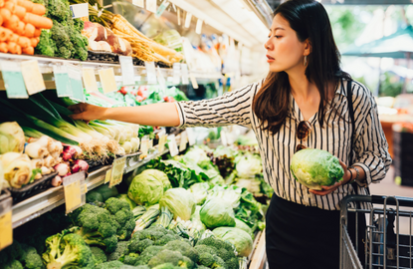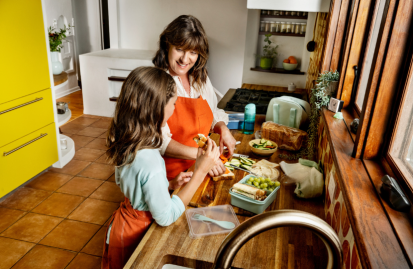Increase Your Fresh Fruits and Vegetable Shelf Life
Shopping in the fresh produce aisle is one of the best things you can do for your health. Fresh fruit and vegetables are full of nutrients, they taste better, and even beginner home cooks can get stuck into the cooking. But let’s face it, fresh fruits and vegetables don’t last forever, and they often spoil faster than you may have anticipated. So how do you extend their shelf life? Here are 7 easy ways to ensure you get the most out of your fresh produce and reduce food waste.
Shelf Life Meaning
The shelf life of fruits and vegetables is the usable life of the food once harvested. Or simply the time when the item is safe for you to eat.
Shelf Life Vs. Expiration Date
A manufacturer sets the expiry date, which is when you should use the food to avoid adverse effects. However, an expiration date is more commonly used for medication which may cause problems if consumed after the pre-determined safe date.
However, when shopping in the supermarket, you may find some items with a date on the packaging. This is usually a best-before date showing the estimated time when the food will peak.
Fresh foods are only sometimes labeled with a date, as many factors affect the quality and usability of the food. Therefore, it is important to know how to prolong the life of your foods once they enter your home.
Factors that Affect Shelf Life
Factors such as temperature changes or extreme heat or cold, ethylene exposure, humidity, bacteria, and physical damage can result in reduced shelf life for your fresh fruits and vegetables. However, this article can help you avoid these common pitfalls that can cause your fresh foods to go bad.
7 Top Tips to Increase the Shelf Life of Fresh Foods
1. Buy Seasonally
We are lucky enough to live in a time where we can access most fruits and vegetables all year round. Technology and faster transport mean we can access mangos in December and apples in May. However, this easy access to out-of-season foods can come at a price. Not only can out-of-season fresh fruits and veggies be more expensive, but they may also taste less good or keep as long after purchase.
So shop seasonally when you can and learn new recipes for different months to use produce when it’s in its optimal state.
2. Buy Local Produce
Farmer's Markets are a great place to source your fresh fruits and vegetables as you can buy them directly from the farmers. Not only is this an excellent way to support local business, but your food will usually last longer as it hasn’t had to ensure hours or days of transport like the majority of fresh produce in the grocery store.
3. Wash Your Produce
This next tip to wash your produce after purchasing is somewhat debated by the community of online foodies and home cooks. Some people think it is unnecessary and you’re better off washing food before you eat it. However, from our research, we believe it’s best to wash some fresh produce before storing it to get rid of any residential bacteria. For example, berries usually benefit from a vinegar solution wash (1 part plain white vinegar and 3 parts water) before storing. However, if you are particularly worried about bacteria, you may prefer to wash your food before you eat it instead of washing it pre-storage.
4. Remove Stickers From Your Fruit After Purchasing
You may have noticed a small sticker on some fresh foods, such as apples or pears. The stickers can hold bacteria or even release small amounts of ethylene which may cause your foods to go bad before their time. So although the sticker seems tiny and harmless, it’s best to remove all stickers and packaging once you get home from the shop.
5. Separate Some Fruits and Veggies
Sometimes foods can cause produce nearby to ripen at a different rate than usual. Therefore, you may wish to relocate certain fresh produce to ensure your food ripens as expected. For example, bananas and avocados can cause other fruits to ripen faster. So keep these in a separate place in your kitchen or dining area to extend the shelf life of the other fruits. You can also store your banana and avocado in a bag to keep them apart from other produce.
Bonus Tip!
As an extra food storage tip, you should also store onions and garlic separately from other fresh produce in your home.
Although this usually doesn’t alter the food’s shelf life, the other fruits and veggies can absorb the odor from the onion and garlic, and you may not enjoy an onion-flavored peach!
6. Choose a Food with Long Shelf Life
It may sound obvious, but if you struggle to use your fresh foods before they go bad, you may benefit from choosing foods with long shelf life. The All Recipes website has a handy guide to the 11 longest-lasting staples for your fresh food pantry. They recommend choosing fruits and vegetables, such as apples and carrots, which can last 3-4 weeks, and cabbage which can last for about 2 months when refrigerated.
7. Learn the Best Storage Locations for Each Food
Just like people, fruits and veggies thrive in different environments. This may sound overwhelming at first. However, you’ll soon get the hang of where to store your fresh produce, and in the meantime, you can write a cheat sheet and stick it to your fridge. As a good rule of thumb, most high-water-content veggies, leafy greens, and berries are best stored in the fridge, while the majority of fruits and some low-water-content veggies do best in a cool, darker area of the kitchen in a basket or other container with good ventilation. For example, tomatoes are best kept with your other fruits in a cooler part of the kitchen out of the fridge. Sweet potatoes, potatoes, and squash can also last considerably longer in your food pantry or another cool, dry place than in the refrigerator, as the fridge may be too moist and cause premature ripening. However, greens such as lettuce, kale, and cucumber will last longer in the fridge. Similarly, carrots, celery, and cruciferous veggies, such as broccoli and cauliflower, will last the longest when they are kept in the refrigerator. It’s also best to keep any half-used fresh foods in the fridge and consume them as soon as possible once you cut into them.
Now, you are well equipped with these tips to extend the shelf life of fruits and vegetables, which can save you money and many frustrating moments in the kitchen. You’ll also be doing your part to reduce waste and help our planet stay healthy!





